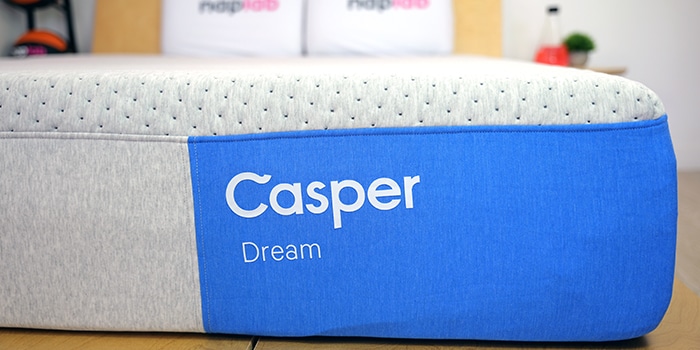
Best For
- High levels of bounce, good for sex
- Fast material response time
- Minimal sinkage with a higher degree of pushback
Considerations
- Moderate levels of motion transfer
- Pressure relief leaves something to be desired (only uses 3.0″ of comfort material)
Our Verdict
The Casper Dream mattress is an 11.5″ hybrid with a combination of poly foam, memory foam, and pocketed coils. In totality, there is 3.0″ of comfort material and 7.5″ of support material.
This mattress offers minimal sinkage and high levels of bounce. If you’re looking for more pushback with and an active, springy feel, the Casper Dream may be a solid pick.
The Casper Dream is available in a single firmness, 6 out of 10, with a medium-firm feel. For reference, this is notably softer than the Casper Dream Max, which has a medium soft feel, 4.5 out of 10.
In our performance tests, the Dream Hybrid had a performance score of 9.45, which is slightly less than the average performance among all mattresses tested to date (9.49).
In addition to the slightly lower performance, this mattress also has a higher price tag. The average hybrid costs $1,380 for a queen and the Dream Hybrid is 8% more than that. The difference is not huge, but could be important to some sleepers.
Type: Hybrid
Firmness: Medium-Firm (6)
Best For: All Sleeping Positions, All Body Weights
In This Review
Performance Tests | Firmness | Support & Sleeping Positions | Design | Materials | Comparisons | FAQs
Performance Tests
At NapLab, we put each mattress to the test.
We test 10 different factors that impact the performance, comfort, and value of the mattress. Testing categories include:
| Test | Rating |
|---|---|
| Cooling | Excellent |
| Sinkage | Minimal |
| Motion Transfer | Moderate |
| Response Time | Extremely Fast |
| Bounce | High |
| Edge Support | Excellent |
| Sex | Excellent |
| Pressure Relief | Very Good |
| Off-Gassing | Very Good |
| Company | Excellent |
How is Casper Dream Different?
The Casper Dream Hybrid has an overall performance level that is slightly lower than the average performance level, as well as a price that is slightly above average—8% higher than the average hybrid ($115 more for a queen mattress).
Advantages
Advantages of the Casper Dream include slightly better cooling performance, faster material response time and better sex performance, thanks largely to the higher level of bounce.
Neutral Factors
This mattress has less sinkage than average and also more bounce than average. Both of these factors are considered neutral factors and the ideal range may change based on personal preference.
Edge support was also basically at the average level, making it a bit of a neutral factor.
Disadvantages
Disadvantages of the Casper Dream Hybrid include higher levels of motion transfer, slower off-gassing, and less comfort material than average (3.0″ on Casper Dream compared to 4.2″ on average).
A thinner comfort layer is more likely to be an issue for heavier sleepers, side sleepers, or those who struggle with pressure relief issues.
| Factor | Casper Dream | Average |
|---|---|---|
| Overall | 9.45 | 9.49 |
| Price | $1,495 | $1,380 (Hybrid only) |
| Cooling | 9.5 | 9.4 |
| Max Sinkage | 1.89″ | 2.16″ |
| Total Motion Transfer | 9.48 m/s² | 8.64 m/s² |
| Response Time | 0.2 sec. | 0.4 sec. |
| Total Bounce | 10.73″ | 9.71″ |
| Edge Support – Sitting Sinkage | 4.00″ | 4.07″ |
| Mattress Thickness | 11.5″ | 12.0″ |
| Sex Overall | 9.8 | 9.6 |
| Comfort Material | 3.0″ | 4.2″ |
| Off-Gassing – Smell | Strong | Strong |
| Off-Gassing – Days | 8 days | 6 days |
| Trial | 100 nights | 164 nights |
| Warranty | 10 years | 25% have lifetime warranties, average of other 75% of mattresses is 14 years |
Cooling Test
The Casper Dream has excellent cooling performance. During our tests, I felt no significant level of heat retention around my body. The Casper Dream has the same level of cooling performance as the more expensive Dream Max Hybrid.
Baseline Temp.
75.0° F
Max Temp.
90.0° F
Ending Temp.
79.7° F
Max Temp.

Ending Temp

- Baseline Temperature – the temperature of the mattress before anyone lies on it
- Maximum Temperature (0 minute) – the temperature of the mattress after lying on it for 15 minutes
- Ending Temperature (5 minute) – the temperature of the mattress after being lied upon and having no one on it for 5 minutes
The mattress uses high-quality materials, open-cell foams, and is supported by a layer of pocketed coils. This combination of materials helps to avoid heat retention, while also bringing more air into the mattress and the foams.
During our objective temperature tests, we measured a max surface level temperature of 90.0°, which is 0.44° warmer than average.
After getting off the mattress the temperature dropped by 6.6° from minutes 0 to 1, which is 2.58° cooler than average. The cooling reduction from minutes 0 to 5 was 10.3°, which is 3.02° cooler than average.
Heat Dissipation Over Time

While the mattress lacks the phase change cover and phase change foams of the Casper Snow and Casper Snow Max, it still provides excellent cooling performance that will be good enough for most sleepers.
Sinkage Test
The Casper Dream has a minimal level of sinkage. In our pressure point tests, we measured a sinkage depth of 1.89”. This is 0.27” less sinkage than the average of 2.16”.
Sinkage Depth
1.89″
Sinkage Feel
Minimal
The level of sinkage is documented in the image below.

Despite the lower level of sinkage, the mattress still creates a balanced and even body-contouring hug. The limited 3.0” comfort layer restrains just how far the body is able to sink.
In addition, the mattress has a moderate to high degree of pushback, especially in the center of the mattress where there is a firmer foam (compared to the foams at the head / foot).
Motion Transfer Test
The Casper Dream has a moderate level of motion transfer. During our tests, we measured an acceleration range of 9.48 m/s². This is 9.7% more motion than the average of 8.64 m/s².
Max. Acceleration
4.31 m/s²
Min. Acceleration
-5.17 m/s²
Accel. Range
9.48 m/s²
The relatively thin 3.0” comfort layer, hybrid design, and minimal sinkage contribute to the slight increase in motion compared to the average.
The level of motion transfer is also documented in the video below.
In our motion transfer chart, which visualizes our accelerometer data, we can see the highest level of motion from 0 to 0.22 seconds.
Motion gradually steps down from there and by 0.75 seconds we reach near-zero levels of energy. Mattresses with the least motion are able to disperse all energy within 0.3 seconds.

Needless to say, the Casper Dream isn’t quite at that level. However, it’s on par with most other hybrid mattresses. I don’t expect this level of motion will be problematic for most sleepers.
Response Test
The Casper Dream has an extremely fast material response time. During our tests, we measured a mostly recovered response of 0.2 seconds and a fully recovered response of 0.4 seconds.
Mostly Recovered
0.2 sec.
Complete Recovery
0.4 sec.
The level of responsiveness is documented in the video below.
This is effectively an instant material recovery speed. Having a less deep level of sinkage helps response, as there just isn’t as much foam contour to rebound back to shape.
In addition, the hybrid design also helps. Given the material recovery speed, the mattress is easy to move around on and won’t create a stuck feeling.
Bounce Test
The Casper Dream has a high level of bounce. During our tests, we measured a total bounce range of 10.73”. This is 1.02” more bounce than the average of 9.71”.
Max. Depth
5.38″
Max. Rebound
5.35″
Total Bounce
10.73″
Max. Sinkage Depth

Max Bounce Height

The level of bounce is also documented in the video below.
Ideally, I want to see 8-12” of total bounce. At this level ease of movement and sex benefits, while motion transfer levels are still kept in check.
At 10.73” of bounce the Casper Dream is right in that sweet spot. I expect most sleepers will find this level of bounce to be acceptable.
Edge Support Test
The Casper Dream has excellent edge support for both sitting and lying. In our sitting edge support tests, we measured a sitting sinkage compression of 4.0”. This is 0.07” less sitting sinkage than the average of 4.07”.
Max Sinkage
4.00″
Lying Support
Excellent
While sitting directly on the edge of the mattress I felt well supported, at least in the center third of the mattress, which is where our standard sitting edge test is conducted.
That said, sitting edge support at the foot and head of the mattress is worse. This is because the Dream Max uses a softer foam at the head and foot. This helps body support, especially for side sleepers, but doesn’t do any favors for sitting.
The level of edge support while seated is documented in the images below.
Sitting, 140 lbs.

Sitting, 200 lbs.

Lying edge support was also excellent. During our tests, I felt well-supported in all sleeping positions while lying directly on the edge of the mattress.
The level of edge support while lying is documented in the images below.
Lying on Edge, 140 lbs.

Lying on Edge, 200 lbs.

The mattress is equipped with a 3.5” wide and 6.0” tall support foam that significantly helps to improve the edge support performance.

Sex Test
The Casper Dream has excellent sex performance. During our tests, we measured a high level of bounce at 10.73” and good edge support (at least in the center third of the mattress).
The zoned foam layer does make edge support notably worse for amorous activities at the head and foot of the mattress, especially if you’re utilizing the edge itself.
That said, the mattress is comfortable, has good cooling performance, and makes virtually no noise. Overall, I’m pleased with the dance without pants performance.

How Do We Determine Sex Score?
The best mattresses for sex have high bounce, good edge support, quiet materials, and good pressure relief and cooling.
These 5 factors make up the NapLab sex performance score.
| Sex Factor | Factor Weight | Score | Rating |
|---|---|---|---|
| Bounce | 60% | 10 | High |
| Edge Support | 20% | 9.5 | Excellent |
| Noise | 10% | 10 | Minimal |
| Pressure Relief | 5% | 9.0 | Very Good |
| Cooling | 5% | 9.5 | Excellent |
For the Casper Dream, these individual factors generated a sex score of 9.8.
Pressure Relief Test
Pressure relief on the Casper Dream is good, but far from amazing. During our tests, I felt a slight to moderate level of building pressure points on my body (mostly isolated to my back).
Comfort Layer
3.0″
Support Layer
8.5″
On the positive side, the mattress uses high-quality foams and the layered design is one we’ve seen strong performance from over the years. However, we only have 3.0” of comfort material on top of 8.5” of combined support materials.

Based on all of our tests to date, on average, we see 4.2” of comfort materials. Suffice to say, Casper’s Dream is well short on that and it really comes through in the comfort dynamic.
There is a significant difference in terms of comfort comparing the Casper Dream vs. Dream Max, which utilizes a 4.5” comfort layer.
At nearly $1,500 it really feels like the Casper Dream should have a thicker comfort layer. The added foam layers in the Dream Max really push it to the next level and lying on the two mattresses side-by-side the difference is abundantly clear.
Off-Gassing Test
Off-gassing on the Casper Dream is strong right out of the box. The odor lasted for 8 days before fully dissipating.
Initial Smell Strength
Strong
Off-Gassing Period
8 days
The average off-gassing period across all mattresses tested to date is 5 days so the Casper Dream is 3 days beyond that.

While this is slower than average, it’s still shorter than some of the worst offenders we’ve tested.
If you’re sensitive to strong odors, this 8-day off-gassing could be an issue, but for many, it is not a deal-breaker.
Company
Casper’s company terms and conditions are pretty typical compared to what we see across the industry. They offer a 100-night trial period and a 10-year warranty on any of their mattresses.
Comparing all mattresses tested to date, the average trial length is 164 nights so Casper’s trial is shorter than average. That being said, 100 nights should still be enough time for you to properly decide if you like the mattress or not.

How Do We Determine Company Score?
The company score takes a look at factors that may influence your experience with the mattress.
Factors include length of the trial period, warranty, shipping / return costs, and country of origin.
| Company Factor | Factor Weight | Score | Data |
|---|---|---|---|
| Trial Period | 25% | 9.0 | 100 nights |
| Warranty | 25% | 10 | 10 years |
| Shipping | 25% | 10 | $0 |
| Returns | 25% | 10 | $0 |
| Country of Origin | 0% | USA |
For Casper, these individual terms and conditions generated a company score of 9.8.
How firm is Casper Dream?
The Casper Dream has a medium-firm feel with a firmness of 6 out of 10. This mattress is only available in a single firmness.

As a general note, the Casper Dream is quite a bit firmer than the Casper Dream Max. In our tests, the Dream Max had a firmness of 4.5 out of 10 and had a medium soft feel. The Dream Max may be better suited to side sleepers or lighter sleepers in general
Support & Sleeping Positions
The Casper Dream has excellent support. During our tests, I felt well-supported in all sleeping positions. The mattress uses a robust 8.5” support layer consisting of a 6.0” pocketed coil unit that sits atop a 2.5” support foam layer.
The 8.5” of support materials are modestly thicker than the average 7.8” support layer, based on all of our tests to date.

In addition, I’m pleased with the inclusion of the zoned foam layer. The center third of the mattress uses a slightly firmer foam in the core of the mattress, creating extra support where many bodies carry extra weight.
The head and foot of the mattress utilize a slightly softer foam in the core, creating a little more sinkage and softness for those areas of the body.
The zoning helps to create a more neutral spinal alignment. Overall, I expect most sleepers will find the support dynamic to be perfectly sufficient.
Check out the table below to see the sleeper weights and sleeping positions that would be best suited for this mattress.
| Sleeper Weight | Stomach Sleepers | Side Sleepers | Back Sleepers |
|---|---|---|---|
| Under 150 lbs. | Yes | Yes | Yes |
| 150-250 lbs. | Yes | Yes | Yes |
| 250-300 lbs. | Yes | Yes | Yes |
Design
The Casper Dream is a hybrid mattress with an 11.5″ total thickness and a medium-firm feel (6 out of 10, where 10 is the most firm).
Type
Hybrid
Thickness
11.5″
Firmness
6
The Dream is Casper’s most basic hybrid option and is designed as a budget-friendly pick for sleepers who don’t need the advanced performance of the Dream Max or the Casper Snow series.

Materials
In total, there are four distinct layers on the Casper Dream, including a mix of foam and coils. From top to bottom, the layers include:
- 1.0” poly foam
- 2.0” memory foam
- 6.0” pocketed coil
- 2.5” support foam
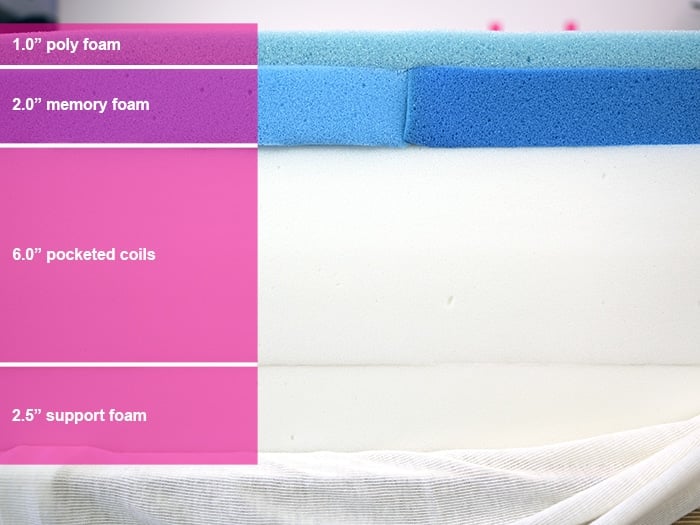
The Law Tag outlines the full breakdown of materials included in this mattress.
- Material
- 100% polyurethane foam pad
- Spring unit
- Cover
- Top – 99% polyester, 1% spandex
- Gray Side – 100% polyester
- Color Side (face) – 50% polyester, 37% rayon, 13% cotton
- Color side (back) – 88% polyester, 12% spandex
- Bottom – 100% polyester
- Made For
- Casper Sleep, Inc. 3 World Trade Center, 175 Greenwich Street, 40th Fl, New York, NY 10007
- Date of Delivery (left blank)
- Finished Size and Net Weight of Filling Material
- Twin – 75 in x 38 in x 12 in, 25 lbs.
- Twin XL – 80 in x 38 in x 12 in, 26 lbs.
- Full – 75 in x 53 x 12 in, 34 lbs.
- Queen – 80 in x 60 in x 12 in, 40 lbs.
- King – 80 in x 76 x 12 in, 51 lbs.
- California King – 84 in x 72 in x 12 in, 51 lbs.
- Made in USA of Imported and Domestic Components
- Manufactured by
- Sinomax USA East Inc., 1740 JP Hennessey Dr, La Vergne, TN 37086
- Date of Manufacturer – March 5, 2024
The Cover
The cover of the Casper Dream Hybrid is a thin, knit-blend with stretch and breathability. There is no tufting for added loft or contour, giving the mattress a modern feel.

The Comfort Layer
Two foam types make up the comfort layer of the Casper Dream. On top, is a 1.0″ poly foam followed by a 2.0″ memory foam. The memory foam is a zoned foam, divided into three sections.
The head and foot foam sections (light blue foam) have a slightly softer feel (with a little more sinkage) while the center piece of foam (darker blue foam) is slightly firmer (with a little less sinkage).

The Support Layer
Beneath the comfort foams is the support system, made of pocketed coils and high-density support foam. The coils are individually encased in a thin fabric and 6.0″ tall.
The foam beneath is a 2.5″ layer of support foam. This is thicker than we typically see beneath coils, but it also may help compensate for the 6.0″ coils (not 8.0″, which is more standard).

The support layer also contains an edge support foam that is 3.5” wide and 6.0” tall. This foam sits atop the support layer and helps contain noise and movement from the coils.

Product Evolution
Casper hit the market in 2014 with its launch of the Casper all-foam mattress. In 2019, Casper hybrids entered the chat and models continued to be added until it hit max capacity in 2023.
In early 2024, Casper discontinued their entire mattress line and launched 5 brand-new mattresses.
Prior to this rework, there were 4 Casper hybrids:
- Casper Original Hybrid
- Casper Nova Hybrid
- Casper Wave Hybrid
- Casper Snow (still available; however it has a new design)
Of these four, the Casper Dream Hybrid appears to be most similar to the Casper Original Hybrid.
Casper’s 2024 lineup includes:
- Casper One – all foam, most basic, least expensive
- Casper Dream – least expensive hybrid
- Casper Dream Max – higher performance hybrid
- Casper Snow – less expensive, cooler hybrid
- Casper Snow Max – higher performance, cooler hybrid
Casper Dream vs. Casper Dream Max
The Casper Dream and Dream Max are two mid-range hybrids offered by Casper. The Dream is the most basic mattress model between the two. For advanced cooling in a Casper Hybrid, check out the Casper Snow or Snow Max, the top-tier Casper mattress options.
Check out the differences between the Dream collection below.

Casper Dream
| Type: Hybrid |
| Thickness: 11.5″ |
| Firmness: 6 out of 10, Medium-Firm |
| This is the review. |
| Overall Score: 9.45 |
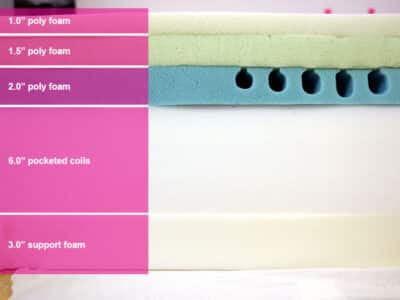
Casper Dream Max
| Type: Hybrid |
| Thickness: 13.5″ |
| Firmness: 4.5 out of 10, Medium Soft |
| Read Review |
| Overall Score: 9.51 |
Other Mattresses to Consider
Not sure if the Casper Dream is the right pick for you? Check out these three other top-rated hybrid mattresses for high-performing alternatives you may want to consider.
For Performance
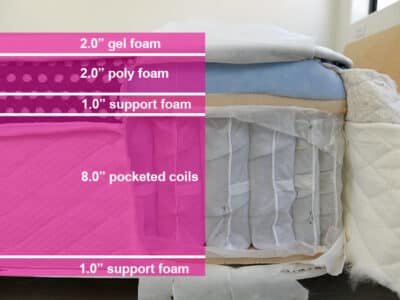
Winkbed
9.95 Overall Score
The Winkbed Original is the highest-performing hybrid we’ve tested to date. It has a 5.0″ comfort layer and outperforms (or ties) the Casper Dream in all 8 performance categories we test for. As an added bonus, this mattress comes in three firmness levels—Softer (4 out of 10), Luxury Firm (6 out of 10), or Firmer (7 out of 10).
For High-Profile
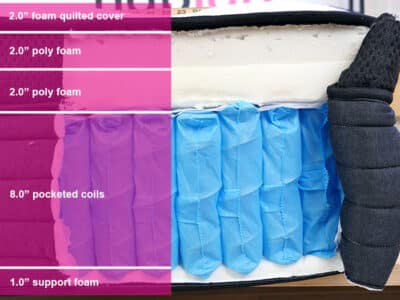
Nolah Evolution 15
9.77 Overall Score
The Nolah Evolution has a 15″ total thickness, which includes 6″ of comfort material. Compared to the 11.5″ thickness of the Casper Dream, the Nolah can be a big step up in terms of pressure relief. This mattress would be the most beneficial for heavier-weighted side sleepers.
For Motion Transfer
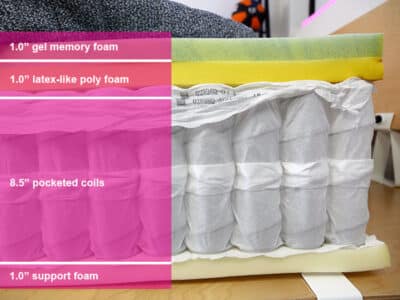
GhostBed Flex
9.72 Overall Score
The GhostBed Flex is a hybrid that combines memory foam, poly foam, and pocketed coils. It has better performance than the Casper Dream (including much lower levels of motion transfer) while retaining a similar price point.
Frequently Asked Questions
Still have questions? Check out some of the top FAQs on the Casper Dream mattress below and get the answers you’re looking for.
Here are the current prices, with any sales or promotions reflected below:
Twin: $1,195
Twin XL: $1,195
Full: $1,395
Queen: $1,495
King: $1,895
Cal. King: $1,895
*Note: Sales prices are subject to change without notice or warning.




